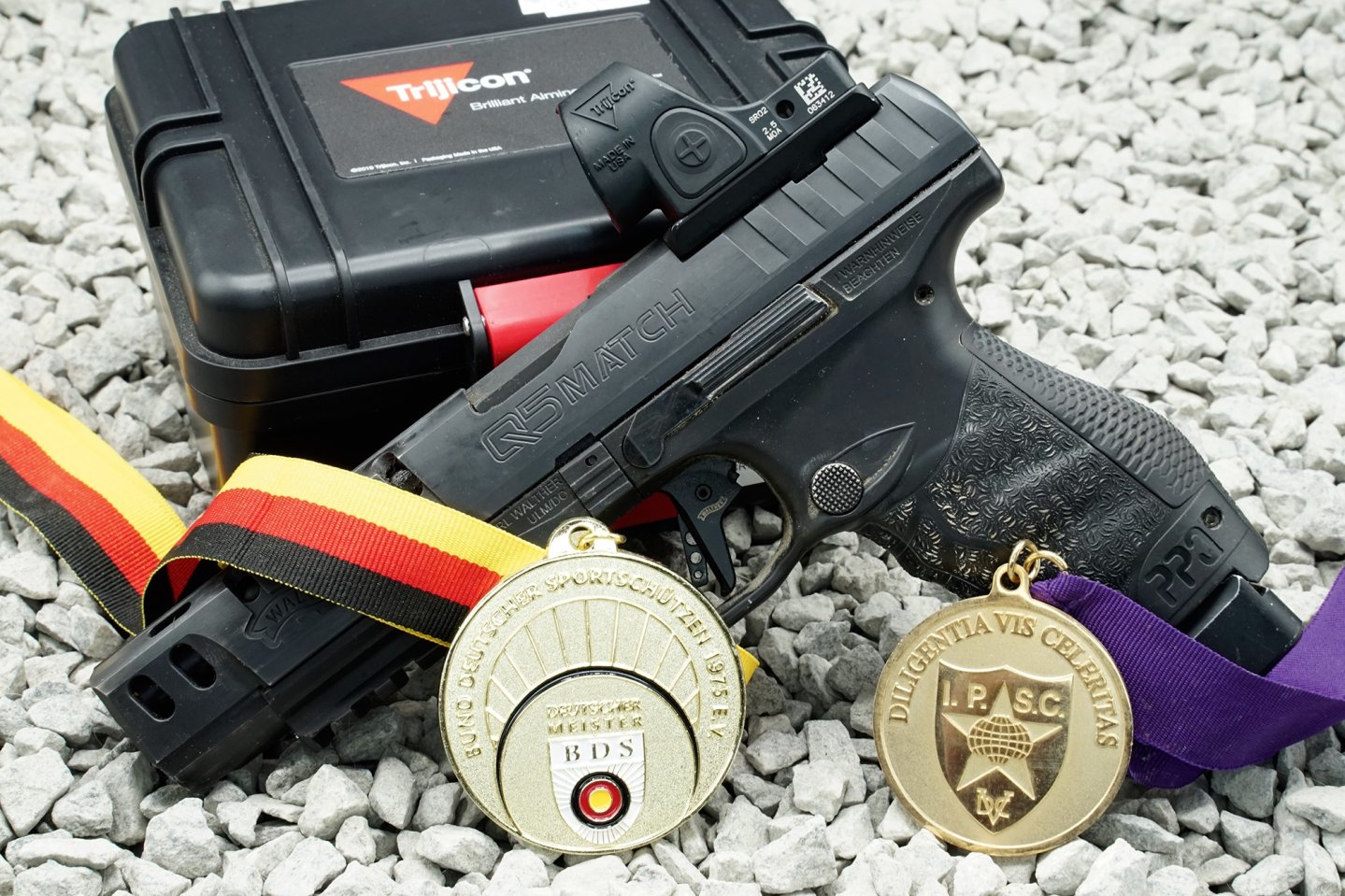Although the Trijicon RMR is mostly used on handguns, it was actually intended as a platform-independent solution for rifles, shotguns, handguns or as a back-up optic. With a lens measuring just 22x16 mm, the RMR offers a relatively small field of view. In addition, it must be disassembled for battery replacement, as the battery compartment is located on the bottom. This is not the end of the world, but a trip to the shooting range is recommended if you want to be on the safe side with regard to the point of impact. In many respects, the competition has not been asleep here and has brought up corresponding alternatives. Leupold is leading the way with its DeltaPoint Pro (DPP) – we tested it here – which enjoys great popularity not only among sport shooters, but also with the 1st Special Forces Command (Airborne), among others. Unlike the RMR, the DPP offers a significantly larger field of view at 25.7x17.5 mm and, thanks to the top-mounted battery compartment, does not have to be disassembled. Looking at the key features of the new SRO, such as the 25x22.5 mm lens and the battery compartment that has been moved to the top of the housing, it appears that the main points have been improved. According to the manufacturer, the SRO is not intended to replace the RMR. Rather, its design as a dedicated short-range optic is intended to complement the existing product catalog. Especially since the SRO is primarily intended for sport shooters and the RMR is still recommended for military/LE users.
The Trijicon SRO from Ferkinghoff International in detail
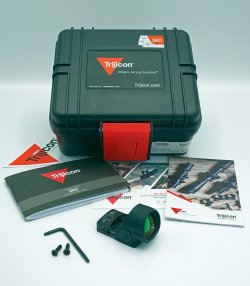
At first glance, the SRO has an unusual appearance due to its large, forward-projecting lens housing. But the design is due in part to the fact that it is a “toploader”; the CR2032 battery is inserted into the housing from the top and the battery compartment is then screwed down with a cover. As mentioned, the lens measures a whopping 25x22.5 mm and impresses with a clear, distortion-free view. The SRO is available with either a 1.0 MOA, 2.5 MOA, or 5.0 MOA dot, with our specimen equipped with the medium dot size. Except for its unconventional appearance, the SRO is similar to the RMR in many respects. For example, the controls in the form of the two push buttons for brightness are located on either side of the window, and the adjustment screws for elevation and windage are neatly recessed in their usual places in the rear of the housing. The case itself is made of forged 7075-T6 aluminum and is claimed to be waterproof up to a depth of 3 meters.
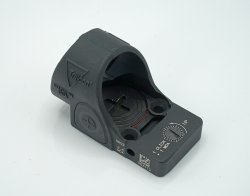
The Trijicon SRO has eight brightness settings, including a so-called Super Bright Mode and two night vision settings. Pressing either button once turns the red dot sight on, and pressing both buttons simultaneously for more than 3 seconds turns it off. When the SRO is turned on, it first "wakes up" in automatic mode, which means that the reticle's brightness is automatically adjusted to settings 3-7 of ambient brightness. If you now press either the "+" or "-" button to adjust the brightness, the SRO will switch to manual mode and remain there. Returning to automatic mode is possible by pressing both switches simultaneously for less than 3 seconds. In addition, the "Lock-Out" and "Lock-in" modes are available, in which the automatic mode or a desired brightness can be locked. According to the manufacturer, the battery life is over three years at medium intensity level (4 out of 8). Thanks to the identical footprint, the SRO can basically be used on any RMR mounting/interface/adapter plate. The mounting is done with two #6-32 UNC countersunk screws. By the way, the completely closed bottom side of the SRO eliminates the need for a separate sealing plate. With the RMR, on the other hand, this is especially necessary when used on handguns, as the optics often protrude over the slide top, allowing moisture to penetrate from below. When mounting on pistols, care should be taken to ensure that the lens does not protrude beyond the slide breech face, otherwise malfunctions may occur.
The Trijicon SRO Red-Dot 2.5 MOA for training and competition
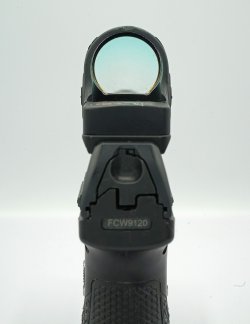
To put the SRO through its paces, it was mounted on a Walther PPQ Q5 Match in 9x19 for most of the hands-on testing. As usual, we were careful to use a torque wrench and follow the manufacturer's instructions when mounting this optic. In the case of our PPQ Q5 Match, Walther specifies a torque of 2 Nm (17 in-lbs) for the two M3x6 socket head screws on the optics mounting plate. Unfortunately, Trijicon does not provide such information and further research was not really successful. Thus, only vague specifications from hand-tight to actual values were found. In the majority of cases, 10-12 in-lbs (with and without screw locking) were mentioned there. This seemed a bit low to us, but in the absence of other validated manufacturer specifications, we stuck to it and tightened the screws provided with screw lock at 10 in-lbs (1.1 Nm) in the standard optics adapter plate.
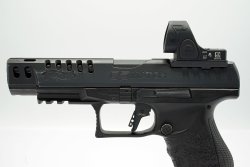
After this small obstacle was overcome, we roughly presighted-in the SRO with the help of a laser cartridge for the beginning, before we finally fired the combo on the shooting range at a spot shot distance of 10 meters. Thanks to our preliminary work with the laser cartridge as well as the precise click adjustment, the last part of the preparations was done with just a few shots. After some experiments, a spot shot distance of 10 meters proved to be the most practical for dynamic applications, since this results in a high shot of 2 cm at 25 meters and a low shot of only 1 cm at 50 meters with subsonic cartridges, which is ultimately negligible in most cases or likely to be lost in the grouping. At the beginning we first shot some standard static exercises like bill drills, 1-5 drill or the El Presidente to familiarize ourselves with the SRO, before we shot a typical IPSC stage with various shooting positions and different target setups the same evening. With each run, we got more comfortable with the SRO and soon didn't want to miss the combination of a large lens and a sparkling clean, precise 2.5 MOA dot, so we quickly decided to use it for the upcoming German IPSC Championship in Production Optics Light (POL). In the weeks leading up to the championship, the SRO swallowed well over 3,000 rounds in training without a hitch. Even in the brightest sunshine, the fine illuminated dot could be picked up quickly, precise hits could be achieved, and even in the fastest fire strings, the dot did not leave the lens. In other words, “test passed”.
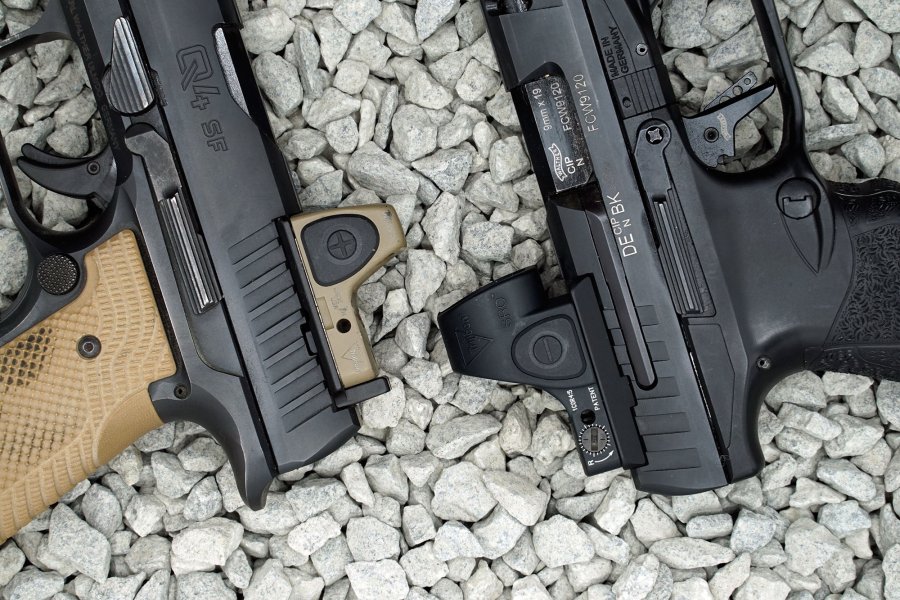
Trijicon SRO red dot specs and price
| Model: | Trijicon SRO |
| Housing
Material: | 7075
aluminum (hard anodized, black) |
Lens Window (HxW): | 25x22.5
mm |
| Dimensions
(LxWxH): | 55x32x34
mm |
| Weight: | 46.5 g |
| Dot Size: | 1.0 MOA /
2.5 MOA / 5.0 MOA |
| Brightness
Settings: | 8
adjustable brightness settings (including one Super Bright and two night vision
settings); automatic and manual modes |
| Battery: | 1 x 3 Volt CR2032 |
| Accessories
Included: | CR2032
battery, mounting screws (thread No. 6 - 32 UNC), Torx angle wrench, operating
instructions |
| Elevation/Windage
Adjustment: | 1 MOA
click adjustment; 150 MOA adjustment range |
| Footprint: | Trijicon
RMR |
Price (in Germany): | 1,025
euro |
Test result: Our conclusion on the Trijicon SRO mini dot sight
Once you've enjoyed the extremely large field of view of the SRO, you'll be hooked. This, coupled with the good workmanship, the high image quality of the reticle, a comfortable operation (large push buttons, easily accessible battery compartment), the precise click adjustment and the usual Trijicon reliability quickly made the SRO one of our favorite optics. But unfortunately two downers cloud the resume: the price of 1,025 euros and the so far rather difficult availability in Europe. Pre-orders are currently possible in the Online-Store of Ferkinghoff International - the German based international Trijicon distributor for Europe.
Learn more about the Trijicon SRO 2.5 here in the Ferkinghoff International online store.


